
The 22nd Guru Kelucharan Mohapatra Award Festival
- Lalitha Venkat
e-mail: lalvenkat@yahoo.com
Photos: Arabinda Mahapatra
September 12, 2016
In a city of festivals, Srjan’s Guru Kelucharan Mohapatra Award Festival
has a special place in the hearts of the people, not only because it is
dedicated to the revered maestro but also because of the impeccable
arrangements and execution of the festival in all aspects. The 22nd
edition took place from September 5 to 9, 2016 at Rabindra Mandap,
Bhubaneswar. As in earlier years, the brevity of the inaugural function
was impressive. The stage decor was minimalistic with on the right
corner, just one big b & w image of Kelubabu with folded hands and a
beatific expression on his face. There was a one minute silence
observed to the memory of scholar and painter Dr. Dinanath Pathy who
passed away recently.
The inaugural evening took off with a riveting performance by the three
celebrated Odissi dancers Aruna Mohanty, Sujata Mohapatra and Meera Das,
clad in attractive white costumes with different colored borders. They
commenced with a Mangalacharan to lord Jagannath followed by Hamsadwani
pallavi, the group coordination and perfection of their movements
holding the audience spellbound. The main piece was Nari, conceived by
Aruna Mohanty with script by Kedar Mishra. The 3 strong women characters
were originally conceived as Sita, Radha and Meera but adapted to
replace Radha with Shabari depicted movingly by Sujata, thus taking on a
devotional hue. Aruna’s expressive depiction in the role of Sita and
Meera Das as saint Meera was much appreciated. They choreographed their
individual pieces while Shabari was choreographed by Ratikant Mohapatra.
The artistes had ample scope to show their abhinaya skills in these
solos interspersed with linking scenes conceived imaginatively. The main
incidents in the lives of the 3 women unfolded through the evocative
choreography, ending in a pure dance item imbued with joy. The
enthralled audience gave them a standing ovation.
The distinguished accompanying artistes, all in black, included Ratikant
Mohapatra and Bijaya Kumar Barik on mardala, Rupak Kumar Parida on
vocal, Ramesh Chandra Das and Agnimitra Behera on violin, Srinivas
Satpathy on flute and Ekalabya Muduli on manjira. At times, the sounds
of the mardala overwhelmed the rest of the music ensemble. Light
direction was by Jaydev Das.
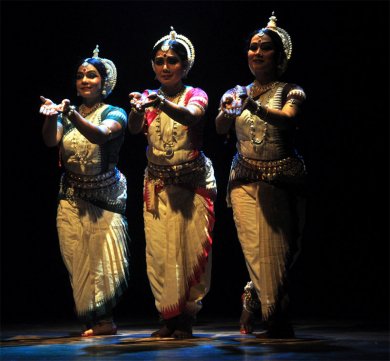
Meera Das, Aruna Mohanty, Sujata Mohapatra
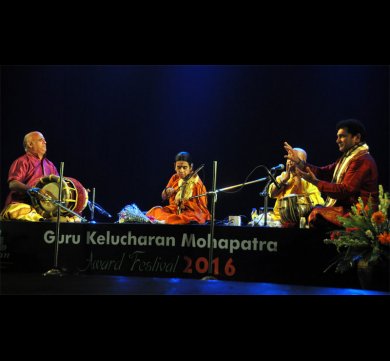
Kanya Kumari and group
In the second half of the evening, the mellifluous tones of A. Kanya
Kumari’s violin reverberated through the hall. She started with Vathapi ganapathim in Hamsadwani followed by a Thyagaraja composition Sogasu chuda in ragam Kannada Gowla, Paratpara in Vachaspati, Krishna nee begane
and a few other pieces. She asked the audience to guess the ragam of
the main composition and it was interesting to see the music composers
sitting in front of us guessing and enlightening us! She was accompanied
by Pt. Rajendra Nakod (tabla), B. Rajashekar (morsingh) and T.K. Shekar
(thavil). The joy with which they played added to the charm, seeing the
second standing ovation of the evening, but one wished there could have
been more relaxed passages in the recital. Originally scheduled
saxophone maestro Kadri Gopalnath was indisposed and hence Kanya Kumari
who was to accompany him, gave the main recital.
Day two commenced with a dance theatre Rama Katha, conceptualized by
Usha RK and performed by Bangalore based Sathyanarayana Raju. The story
of Rama was enacted through various characters who impacted his life and
Sathya switched roles with ease, his superb body language for each
character so distinct from the other. Be it the devoted mother Kausalya,
harassed father Dasaratha, scheming Manthara, the demanding Kaikeyi,
Sathya’s theatrics were impressive. A specially charming scene was when
Manthara pours out her schemes into Kaikeyi’s ears. Other events that
impacted Rama’s life like the boatman Guhan episode and the moksha for
Shabari were well visualized. In the depiction of the devoted Anjaneya
and his heroics in Sri Lanka, Sathya’s gait as the monkey god was
compact and not overly done. After the vanquishing of Ravana and the
reunion of Sita and Rama, ending on a brief thillana in praise of Rama,
the production could have just ended instead of extending to an aarathi
for the bow and arrow hung on a prop (in the form of a tall cross that
somehow did not gel with the theme). It was a delightful experience of a
familiar story where theatrics dominated dance and Sathya was rewarded
with extended applause and a standing ovation. Brilliant lighting by
Surya Rao enhanced the appeal of the presentation. Familiar Thyagaraja
compositions and bhajans were sung soulfully by DS Srivathsa, the
composer of Rama Katha. He was ably accompanied by Shakuntala Prabath on
nattuvangam, Gurumurthy on mridangam and young Kartik on flute.

Sathyanarayana Raju

Ustad Shahid Parvez Khan
The music program of the evening was a brilliant sitar recital by Ustad
Shahid Parvez Khan accompanied on the tabla by Mukesh Jadhav. The
maestro said that music is not only entertainment but also touches the
heart. He chose the raag Charukesi and his varied improvisations of
various phrases, down to the softest tones, had the audience burst into
ecstatic applause every few minutes till they finally settled down to
drown in the magic of the music. His happy smiles and the enthusiasm of
the tabla player added to the charm of the evening and the audience
responded with a standing ovation.
On day three, Odissi dancer Rahul Acharya started his performance with a
Mangalacharan on Hari Hara along with the Hari Hara shabda of the
shabdaswarapata of the Deba Prasad repertoire. In this there is a
description of both Hari and Hara. On one side he holds the conch and on
the other he holds a skull; on one side he wears a resplendent garland
of pearls and on the other he wears a garland of bones; one lives in the
opulence of Dwaraka whereas the other invades the cremation ground.
Originally choreographed by Guru Deba Prasad Das, it has been reworked
by Rahul’s guru Durga Charan Ranbir. The Pallavi in raga Chakravaka was
choreographed by Guru Ranbir with rhythm composition by guru Niranjan
Patra and music by Nirmal Kumar Mohapatra. Rahul chose ashtapadi Priye Charushile
that he has choreographed with music composition by Sukanta Kumar Kundu
in raga Desh and tala rupaka, conceptualized and visualized by Pt
Nityananda Mishra. He concluded with Mokshya with an invocation to the
wellness of the world with the shloka Sarvsham Swastir Bhavatu.
The musicians were Guru Durga Charan Ranbir on manjira, Niranjan Patra
on the mardala, Ramesh Chandra Das on violin, Sukanta Kumar Kundu on
vocal and Srinivas Satpathy on the flute. Obviously the dancer was a bit
under the weather and despite being backed by a distinguished
orchestra, though he showed his technical expertise through conscious
precision of movements, he seemed too restrained in his emotions and
somewhat detached with none of his usual charisma and joy in his dance.
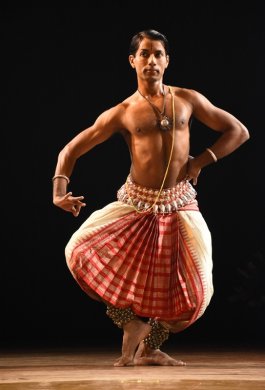
Rahul Acharya
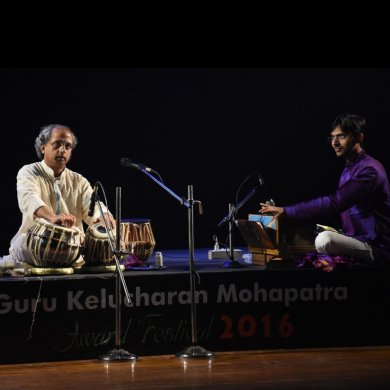
Pt Yogesh Samsi & Tanmay Deochake
Tabla maestro Pandit Yogesh Samsi confessed to performing for the first
time in Bhubaneswar. His fingers flew over the tabla in vilambit,
madhyama and drut laya and his bandishes were received with much delight
by the audience. He was accompanied by Tanmay Deochake on the harmonium
and together they created great music for the evening.
Day four began with a Kathak performance by Guru Asimbandhu Bhattacharya
from Kolkata, who started with an invocatory piece in honour of Lord
Shiva followed by upaj, tihai, thaat and aamad. He concluded with an
abhinaya item to a soulful composition by Jagjit Singh - Tere khushboo mey basey kath
- sung soulfully by Debashish Sarkar. This item saw more chakkars than
actual abhinaya and Bhattacharya finished the item dramatically by
snuffing out the candle light (placed on a low stool along with the love
letters) with his bare palm! He was accompanied by Subhankar Banerjee
on tabla, Chandrachur Bhattacharjee on sitar, and Ranjani Bhattacharjee
on manjira.
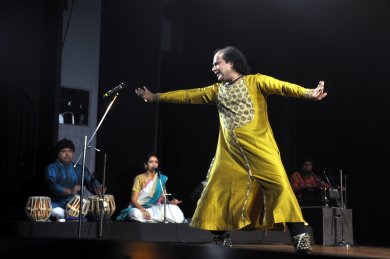
Asimbandhu Bhattacharya
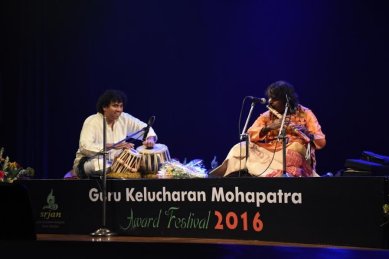
Satyajit Talwalkar & Praveen Godkhindi
The flute recital by Pandit Praveen Godkhindi filled the auditorium with
a peaceful aura. From the moment he started with raag Maru Bihag, he
held the audience enthralled and a standing ovation coupled with an
encore for one more had the maestro play a number in raag Mishra Pahadi
to a second standing ovation. He was accompanied on tabla by Satyajit
Talwalkar.
The final day of the festival featured the most important aspect of the
festival - conferring of the awards. For the last 21 years Guru
Kelucharan Mohapatra Award has been presented on an annual basis in the
field of dance, music, theatre and cinema to exceptional individuals who
have dedicated their lives to their art with a cash prize and a
citation. Two such awards are presented each year. From this year the
award amount has been increased to 1 lakh rupees per awardee. Since the
National Aluminum Company (NALCO) agreed to sponsor the awards, the
awards carry as prefix the name of the company. The ‘NALCO Guru
Kelucharan Mohapatra Award 2016’ for lifetime achievement was presented
to Odissi Guru Kishor Kumar Mohanty in the field of dance and Jharana
Das in the field of cinema. The ‘NALCO ‘Guru Kelucharan Mohapatra Yuva Pratibha
Samman’ carrying a cash prize of Rs 25,000 each was awarded to four
meritorious young artistes in the area of classical dances and Odissi
music for their exceptional diligence and accomplishment. The awardees
are Rajib Bhattacharya (Kolkata) and Madhusmita Mohanty (Bhubaneswar)
for Odissi dance, P. Praveen Kumar (Bangalore) for Bharatanatyam and
Rupak Kumar Parida (Bhubaneswar) for Odissi music. Another award ‘Nrutya
Kala Samman’ with a cash prize of Rs 35,000 went to Odissi dancer
Madhubrata Satapathy. The awards were given away by Chief Minister
Naveen Patnaik.
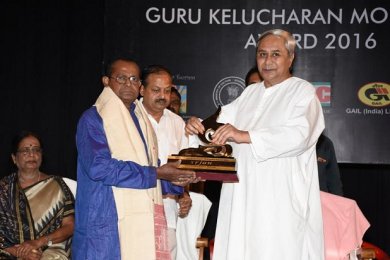
Guru Kishor Kumar Mohanty receives the award from the Chief Minister
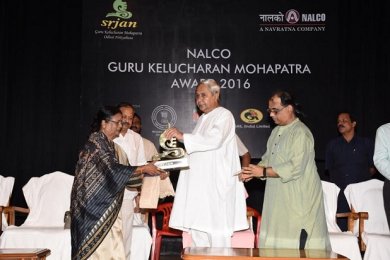
Jharana Das receives the award from the Chief Minister
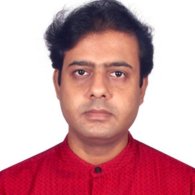
Rajib Bhattacharya
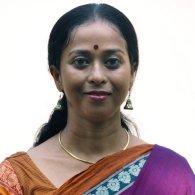
Madhusmita Mohanty
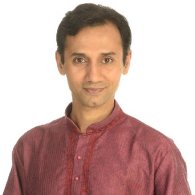
P. Praveen Kumar
As a grand finale to the festival, the meticulously trained 8 member
Srjan repertory premiered Tyaaga, choreographed by Ratikant Mohapatra in
Odissi style and adapted to Odiya Geetinatya art form employing its
typical musical and theatrical elements. The production is based on the
popular drama Lakhyaheera by Kartik Ghosh. The script and lyrics are by
Jaydev Das and the music by Lakshmikant Palit, who used to act in
Geetinatya.
Tyaaga is a story about 2 women, the twists and turns in their lives and
the way they deal with extreme situations, showing the value of
devotion and sacrifice. The story starts with a prayer to lord
Jagannath. Anusuya is a beautiful and devout princess and when she has
nothing to give a beggar (a leper) outside a temple, she unthinkingly
gives him a garland of lord Shiva and thus by an accident of fate, she
is deemed married to the characterless leper Bishnu Das, much to the
shock of everybody. Anusuya considers it her fate, accepts it and is a
devoted wife. The sutradhars then tell the story of Radha who goes to
visit her parents with her husband’s friend Bishnu Das. When Das tries
to act physical with her, she curses him and he becomes a leper. She is
turned away by her husband and in-laws and with no way to support
herself, Radha becomes a high class prostitute and calls herself
Lakhyaheera. To appease the lust of her husband when he sets eyes on
Lakhyaheera by the river, Anusuya is prepared to surrender her body to a
dissolute king for one lakh diamonds. The king asks her to seek her
husband’s permission and the shameless man does so to attain what he
wants. This shocks the king who considers Anusuya’s sacrifice supreme
and regards her as a mother figure from then on. Lakhyaheera in keeping
with her commitment also prepares to make the unthinkable compromise of
surrendering herself to the leper’s lust. Fortunately, Bishnu Das who
takes the plain water rather than scented water offered by Lakhyaheera
to quench his thirst, sees sense and returns to his wife. Thus both king
and leper are transformed by the nobility and devotion of the two
women. But the happy couple is cursed by a meditating sage that Das will
die by sunrise. Anusuya wills the sun not to rise. Lord Vishnu arrives
and requests Anusuya to take back her words for the good of the world,
Das dies but with blessings of Vishnu, he is revived and also cured of
his disease.
In Geetinatya, dancers sing and dance but here recorded track is used
since the dancers cannot sing. Geetinatya has significant music and
movement and a signature tune. Instruments used are dolki, clarinet and
harmonium. During interludes, actors cross each other. One could see all
these elements in the presentation along with folk elements. As a
child, Ratikant had attended these recitals in Cuttack, in which his
father Kelubabu used to act and also play the dolki. Sutradhars are used
to convey the story and they also play the characters. The dancers were
asked to use their imagination to portray the characters. No character
costume is used, only simple Odissi costume (by Baikuntha Das)
since the challenge then is far greater to portray a character. Of less
than an hour duration, the compactly edited story was flawlessly
executed by the superbly trained dancers who excelled in both the nritta
and abhinaya segments, their precise movements and coordination
impressive and a pleasure to watch. Rajashri Praharaj as the devout
Anusuya, Preetisha Mohapatra as the depraved king and garuda, Shipra
Swain as the king and rishi, Aishwarya Singhdev as Lakhyaheera, Sanjay
Kumar Behera as Bishnu Das, Riyanka Chakrabarty, Pragna Parimita Das and
Ritu Sengupta as sutradhars - each character was delightfully enacted
and the exits and entries smooth and aesthetic, proof of the high
standard of training at Srjan, where the repertory rehearses through the
year. Lighting by Jaydev Das and Debiprasad Mishra added to the appeal
of Tyaaga.
Music accompaniment had Ratikant Mohapatra on mardala, Lakshmikant
Palit, Rupak Kumar Parida, Mitali Chinara, Khitiprakash Mohapatra,
Bandish Pait, Tapu Mishra, and Ira Mohanty on vocal, Prabir Sarkar,
Soumitra Byapari and Agnimitra Behera on violin, Srinivas Satpathy on
flute, M. Simadri on flute and clarinet, Bhabtosh Mohanty on surmandal,
Rabishankar Pradhan on sitar and Bibhuprasad Tripathy on keyboard.
Slide show
Tyaaga by Srjan Repertory
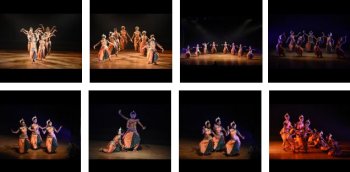
The affable Srinibas Ghatuari and the poised Nazia Allam (who is more
known as a vocalist) kept the program together with their brief
announcements in Odiya and English. To mount a festival of this
magnitude every year requires the all important funding which is getting
more and more difficult, confesses Ratikant Mohapatra. To honor the
memory of his father who inspired and touched the lives of so many,
Ratikant is determined to continue his contribution to the arts by
presenting this festival where “the platform deserves only the best” and
to expose the Odiya people to the talents of great maestros. The Guru
Kelucharan Mohapatra Award Festival is fittingly considered the best
organized festival in Odisha thanks to the organizational skills of
Ratikant Mohapatra and Debiprasad Mishra (Tikki) and one wishes them all
the best for future editions of the festival.
Lalitha Venkat is the content editor of narthaki.com
|





